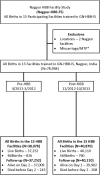Comparison of perinatal outcomes in facilities before and after Global Network's Helping Babies Breathe Implementation Study in Nagpur, India
- PMID: 31484498
- PMCID: PMC6724302
- DOI: 10.1186/s12884-019-2480-7
Comparison of perinatal outcomes in facilities before and after Global Network's Helping Babies Breathe Implementation Study in Nagpur, India
Abstract
Background: The Helping Babies Breathe (HBB) educational program focuses on training of first-level birth attendants in neonatal resuscitation skills for the first minute of life (The Golden Minute). Pre-post studies of HBB implementation in sub-Saharan Africa and Asia have shown reductions in facility-based very early neonatal mortality and stillbirth rates. However, the Global Network pre-post HBB Implementation Study (GN-HBB-IS) found no difference in day 7 perinatal mortality rates (PMR-D7) among births to women participating in the Global Network's Maternal and Newborn Health Registry. To address potential differences in perinatal outcomes in births occurring in facilities that implemented HBB vs. all births occurring in the communities served by facilities that implemented HBB, we compared day-1 perinatal mortality rates (PMR-D1) among births occurring pre and post HBB implementation in facilities in Nagpur, India, one of the 3 sites participating in the GN-HBB-IS.
Methods: We hypothesized that there would be a 20% decrease in the Nagpur facility based PMR-D1 in the 12 months post GN HBB implementation from the pre-period. We explored pre-post differences in stillbirth rates (SBR) and day-1 neonatal mortality rates (NMR-D1).
Results: Of the 15 facilities trained for the GN-HBB-IS, 13 participated in the Nagpur HBB Facility Study (Nagpur-HBB-FS). There were 38,078 facility births in the 12 months before the GN-HBB-IS and 40,870 facility births in the 12 months after the GN-HBB-IS. There was 11% overlap between the registry births analyzed in the GN-HBB-IS and the facility births analyzed in the Nagpur-HBB-FS. In the Nagpur-HBB-FS, there was a pre-post reduction of 16% in PMR-D1 (p = 0.0001), a 14% reduction in SBR (p = 0.002) and a 20% reduction NMR-D1 (p = 0.006).
Conclusions: In the Nagpur-HBB-FS, PMR-D1, stillbirths and NMR-D1 were significantly lower after HBB implementation. These benefits did not translate to improvements in PMR-D7 in communities served by these facilities, possibly because facilities in which HBB was implemented covered an insufficient proportion of community births or because additional interventions are needed after day 1 of life. Further studies are needed to determine how to translate facility-based improvements in PMR-D1 to improved neonatal survival in the community.
Trial registration: The Global Network HBB Implementation Study (GN-HBB-IS) was registered at ClinicalTrials.gov: NCT01681017 .
Keywords: Asphyxia; Community births; Essential newborn care; Facility births; Global Health; Helping babies breathe; Implementation science; India; Neonatal mortality; Perinatal mortality; Pre-post design; Stillbirths; Training.
Conflict of interest statement
The authors declare that they have no competing interests.
Figures
Similar articles
-
Implementation and evaluation of the Helping Babies Breathe curriculum in three resource limited settings: does Helping Babies Breathe save lives? A study protocol.BMC Pregnancy Childbirth. 2014 Mar 26;14:116. doi: 10.1186/1471-2393-14-116. BMC Pregnancy Childbirth. 2014. PMID: 24670013 Free PMC article.
-
A pre-post study of a multi-country scale up of resuscitation training of facility birth attendants: does Helping Babies Breathe training save lives?BMC Pregnancy Childbirth. 2016 Aug 15;16(1):222. doi: 10.1186/s12884-016-0997-6. BMC Pregnancy Childbirth. 2016. PMID: 27527831 Free PMC article.
-
Helping Babies Breathe (HBB) training: What happens to knowledge and skills over time?BMC Pregnancy Childbirth. 2016 Nov 22;16(1):364. doi: 10.1186/s12884-016-1141-3. BMC Pregnancy Childbirth. 2016. PMID: 27875999 Free PMC article.
-
Helping Babies Breathe and its effects on intrapartum-related stillbirths and neonatal mortality in low-resource settings: a systematic review.Arch Dis Child. 2020 Feb;105(2):127-133. doi: 10.1136/archdischild-2018-316319. Epub 2019 Jul 5. Arch Dis Child. 2020. PMID: 31278145
-
The impact of the Helping Babies Survive program on neonatal outcomes and health provider skills: a systematic review.JBI Database System Rev Implement Rep. 2018 Mar;16(3):701-737. doi: 10.11124/JBISRIR-2017-003535. JBI Database System Rev Implement Rep. 2018. PMID: 29521869
Cited by
-
Effectiveness of Neonatal Resuscitation Training Programs, Implementation, and Scale-Up in Low- and Middle-Income Countries.Neonatology. 2025;122(Suppl 1):52-83. doi: 10.1159/000542539. Epub 2024 Nov 22. Neonatology. 2025. PMID: 39581184 Free PMC article.
-
Assessing the effectiveness of newborn resuscitation training and skill retention program on neonatal outcomes in Madhesh Province, Nepal.PLOS Glob Public Health. 2022 Oct 21;2(10):e0000666. doi: 10.1371/journal.pgph.0000666. eCollection 2022. PLOS Glob Public Health. 2022. PMID: 36962548 Free PMC article.
-
What Helping Babies Breathe knowledge and skills are formidable for healthcare workers?Front Pediatr. 2023 Jan 30;10:891266. doi: 10.3389/fped.2022.891266. eCollection 2022. Front Pediatr. 2023. PMID: 36793503 Free PMC article.
-
Effect of the Helping Babies Breathe Program on Newborn Outcomes: Systematic Review and Meta-Analysis.Medicina (Kaunas). 2022 Oct 31;58(11):1567. doi: 10.3390/medicina58111567. Medicina (Kaunas). 2022. PMID: 36363524 Free PMC article.
References
MeSH terms
Associated data
Grants and funding
LinkOut - more resources
Full Text Sources
Medical



